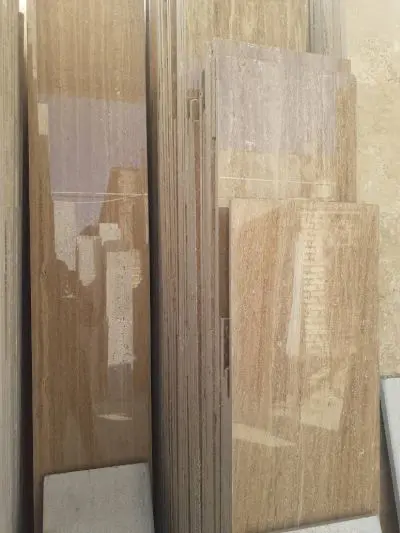In general, during the process of forming travertine deposits, hot water passes through the layers of carbonate rocks, especially limestone, and due to its acidity, dissolves the calcium carbonate in these rocks and forms it as a carbonate and bicarbonate solution when they move themselves to the ground

Travertine is a sedimentary Rock that forms from the precipitation of calcium carbonate in groundwater. It is primarily composed of calcite, a mineral that is also the main component of limestone. Travertine formation begins with the presence of a source of calcium carbonate, which is usually limestone or marble. These Rocks contain high concentrations of calcium carbonate minerals. Groundwater, typically rich in dissolved carbon dioxide (CO2), percolates through the limestone or Marble rocks. As the water moves through the rock, it dissolves small amounts of calcium carbonate.
The appearance and texture of travertine can vary depending on the specific conditions during its formation. Factors like impurities, mineral content, and the presence of other Minerals or elements can contribute to the color variations and unique patterns found in travertine. Travertine is often associated with areas where there are hot springs or geothermal activity, as these environments provide the ideal conditions for the precipitation of calcium carbonate. Notable examples of travertine formations include the travertine terraces of Pamukkale in Turkey and the Mammoth Hot Springs in Yellowstone National Park, USA.
Travertine is a limestone that is formed by the activity of hot springs. In general, during the process of forming travertine deposits, hot water passes through the layers of carbonate rocks, especially limestone, and due to its acidity, dissolves the calcium carbonate in these rocks and forms it as a carbonate and bicarbonate solution when they move themselves to the ground. On the surface, due to the pressure drop, the decrease in the heat of carbon dioxide release as well as evaporation, calcite crystals are formed and deposited in thin layers on top of each other. The stability of the mentioned conditions and the continuation of the formation of calcite layers, causes the formation of uniform layers of porous calcium carbonate (travertine) whose thickness varies from a few centimeters to several meters and usually with a gentle slope on the old rock layers.
Changing the deposition conditions can cause an interruption in the formation of these layers, which results in a separation surface between successive layers of travertine. The total thickness of travertine layers usually varies from a few meters to several tens of meters. The presence of air hub bubbles as well as impurities of divalent iron, trivalent iron, manganese, silica, organic matter, etc. cause considerable color variation in travertine reserves in white, milky, cream to beige, pink, brown , Gold, yellow, lemon, red and green can be formed. In addition to the variety of colors that create a special beauty in these types, this type of Stone can be cut from two different directions.
When the groundwater containing dissolved calcium carbonate reaches the surface or encounters a change in pressure or temperature, it releases carbon dioxide gas. This release of carbon dioxide causes the calcium carbonate to precipitate out of the water. The precipitation of calcium carbonate forms mineral deposits that accumulate over time. These deposits build up in layers, either directly on the surface or around the openings of springs and other water sources. The deposition and accumulation of calcium carbonate give rise to various travertine features, such as stalactites, stalagmites, and travertine terraces. The formation of these features is influenced by factors such as the flow rate of the water, the presence of organic matter, and the interaction with vegetation.



